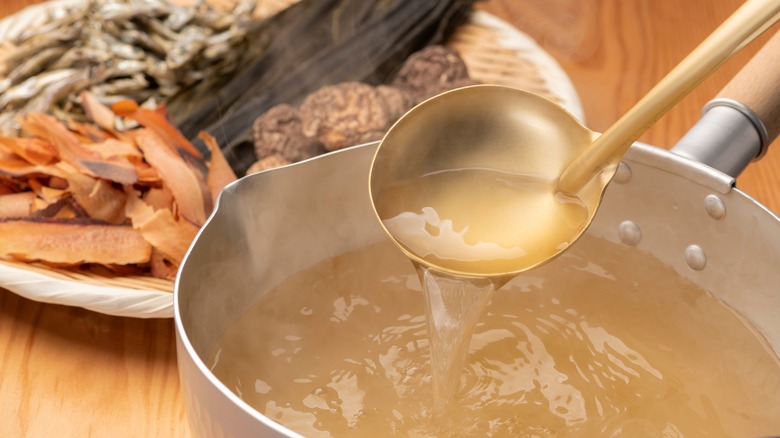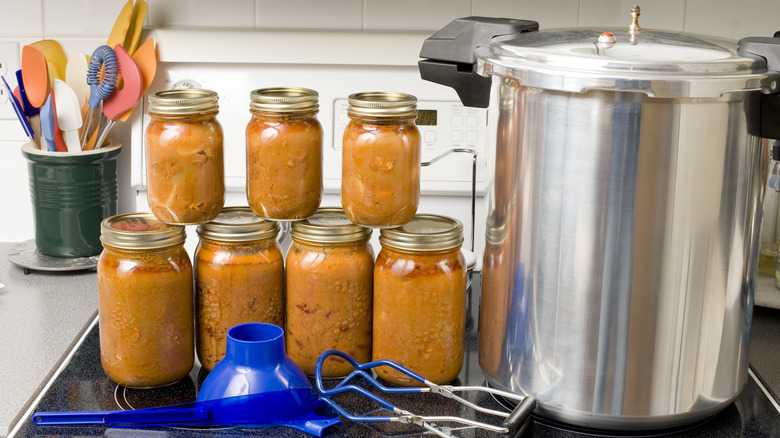What You Need To Know Before Making Your Own Canned Soup
Everyone makes a huge deal out of the arrival of pumpkin spice, but let's not overlook the fact that when the seasons change and the leaves start to fall, it also marks the start of soup season. From classic chicken noodle to apple and butternut squash soup and hundreds more, the crock pot and stove top should be cranked up and turning out soupy goodness the second you see the first PSL hit the market. There's a catch, however: You need space to store all that soup. If you want to free up your refrigerator and freezer, pressure canning is a great way to store soup for long periods at room temperatures, and as long as you can follow directions, it's not particularly hard to do. When you're making soup for pressure canning, however, be sure to leave out any starchy ingredients like pasta and potatoes, or thickening agents, because they will mess up the heating process you'll be doing with canning. You'll also need to skip any cream or milk because they aren't safe to can at home.
That doesn't mean you can't make any kind of soup you want if you're planning to do some canning, you just need to be mindful about leaving certain ingredients out that you can mix in later when you open the can.
Canning constraints
While there are tons of different kinds of canned soup in stores these days, it's still nice to make your own soup to have around for the winter months. Making your own soup for canning gives you a lot more flexibility as far as flavors go, plus you have total control over what ingredients you use. Canning has become trendy again lately thanks to the pandemic and the economy, according to Vox, so the tools and materials you'll need to get started are pretty easy to find.
The process of pressure canning is, basically, sealing food inside a jar without extra air and then heating it to 240 to 250 degrees Fahrenheit in a pressure canner. A pressure canner is just a big pot with a locking lid that allows you to control the amount of steam that escapes, and the heat can get much hotter than boiling water. You need those high temps to kill all the microorganisms in foods with low acid, as opposed to boiling water canning, which you can use for preserving jelly, jam, and other high-acid foods like tomatoes and pickles.
The problem with starchy ingredients like rice, pasta, and potatoes, is that they interfere with heat transfer during the canning process, according to PennState Extension. The same goes for any type of thickener such as flour, cornstarch, or tapioca.
Don't can any dairy
When it comes to dairy, any ingredient like milk, cream, cheese, or yogurt is off limits for canning because these foods are low in acid and can cause Clostridium botulinum spores to grow, even after being exposed to the high heat from a pressure canner. These spores cause botulism, which the CDC says is "a rare but serious illness caused by a toxin that attacks the body's nerves and causes difficulty breathing, muscle paralysis, and even death."
There's no need to scrap your soup plans just because you can't preserve certain ingredients, however. Just make your soup recipe to spec, leaving out any starchy or milky ingredients. Can the soup in the pressure canner, and then later when it's time to eat the soup, just add in the extra ingredients when you heat the soup back up.
If you need to thicken the soup before serving it, just whisk your starch with a ladleful of soup before it's heated so that you don't get any clumps, then stir everything together over the heat. As for potatoes, pasta, and rice, you can just add a handful when you pour the jar of soup into the pot and heat everything up at the same time.
Some recipes just really aren't suitable for canning, however, so leave your creamy chowder recipes for eating immediately, or freeze them if you want to diversify your winter soup supply.


